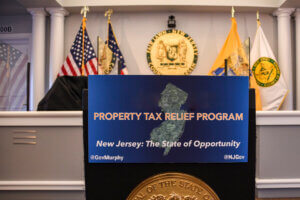Contact:
KATHRYN KLOBY: 732-263-5892 (office) | kkloby@monmouth.edu
THOMAS LAMATSCH: 732-263-5672 (office) | thomas.lamatsch@monmouth.edu
The use of websites by the public sector is gaining significant attention in recent years among practitioners and academics in the fields of public policy, public affairs, and communication. Websites have become one of the most important tools for citizens to get information about municipalities. A recent Monmouth University/NJ Press Media Poll shows that New Jerseyans go online as often as they stop by town halls to get information about their hometowns and they are far more likely to visit a municipal website than call or write a town official.
There is growing recognition that websites can prove to be a useful tool to inform the public, create efficiencies in the provision of public services, and engage the public. This trend is also recognized by the state of New Jersey which now requires, by statute, that certain information, such as the town budgets, be available online. Websites are a vehicle to increase public sector transparency, facilitate open government, and increase public trust in government. Efforts to incorporate technology into public sector service delivery and interact with the public are referred to as E-Government.
The Monmouth University Polling Institute and the Public Policy Graduate Program are conducting a project to examine municipal websites in New Jersey. The aim of this project is building long-term cooperation between New Jersey’s municipalities and Monmouth University researchers to find the best ways to inform citizens through municipal websites, provide services with online transactions, and encourage public engagement using municipal websites. The project will involve professional development seminars and workshops as well as the identification of best practices on what should be available to citizens in various electronic formats. The project will also aim to advance E-Government efforts by regularly evaluating the state of municipal websites. Researchers will examine existing content and check available information and services against a range of accepted standards. As a pilot program in this effort, the project team analyzed Monmouth County municipal websites to establish benchmarks and test the evaluation methodology.
2011 New Jersey E-Government Awards (Monmouth County)
This document describes the methodology used to determine how municipal websites are performing and the criteria used to evaluate municipal websites. A comprehensive list of the items used to determine website performance, the list of scores for all municipalities in Monmouth County, and scores for each award category are available in Appendices A and B. The municipal websites in Monmouth County who were recognized for exemplary performance in E-Government are:
Best Website in Monmouth County: Colts Neck Township
Best Informative Website: Colts Neck Township
Best Citizen-Centered Website : Howell Township
Best Interactive Website : Howell Township, Red Bank Borough
Best Social Networking Website : Asbury Park City, Belmar Borough
Items for Examining Municipal Websites
The team started by defining what constitutes a good website. More than 100 discrete pieces of information and online activities were identified as important for government website design. Importance was determined by applying best practices of E-Government research, integrating examples from award winning websites from communities in and outside of the state of New Jersey [1] , as well as using items identified as important by New Jerseyans in a recent Monmouth University/NJ Press Media Poll [2] . The discrete pieces of information, or items, were then grouped into four categories, generally accepted by practitioners and in scholarly publications: informative items, citizen-centered items, interactive options, and social networking integration. Future studies will use individual items in these four areas to evaluate municipal websites across the state. The criteria were applied in the Monmouth County pilot to find websites that best exemplified integrating these criteria into their website. Appendix A lists all 53 Monmouth County municipalities and how their websites performed in each of the four categories and overall in the four categories combined. Appendix B lists all evaluation items, as well as the weighted scores awarded if the information was available on the website. [3]
Information for Citizens
The purpose of this category is to determine how much information is readily available to citizens. Information ranges from the names and contact information of elected officials and key personnel to schedules for meetings and garbage pickup.
High scoring websites in this category provide information about the following:
- City hall location and hours of operation.
- The name and phone numbers of the mayor and council members
- The name and phone numbers of business administrators or city managers
- Meeting schedules, agendas, minutes, and transcripts for city council, zoning board, planning board, and citizen committees
- Municipal department contact information such as phone numbers
- Permit information, zoning laws, or ordinances
- Garbage and recycling schedules and instructions
- Police, Fire, and EMS contact information as well as crime statistics.
Citizen Opportunities for Engagement
Citizen – centered websites go beyond the provision of information and provide opportunities for citizens to engage government through emails, convey their satisfaction with services, or sign up for alerts or other messages. Websites that are more citizen-centered are more likely to offer opportunities for participation by posting information about citizen advisory committees or professional positions.
High scoring websites in this category include the following:
- The availability of a search box and a suggestion box
- Ability to send emails to the mayor, clerk, business administrator or city manager, and departments
- Email addresses for zoning and planning boards, and citizen advisory committees
- Availability of information on job or board openings and online applications
- Links to participate or receive results of citizen surveys
- Sign-up opportunities for emergency alerts
- Publication of bidding opportunities for municipal contracts
Provision of Interactive Government Services
Websites that are interactive take advantage of web-based technology to conduct online transactions for the convenience of citizens and more efficient public services. Interactive features include the availability of online forms, payment opportunities, and applications.
High scoring websites in this category include the following transactions:
- The availability of downloadable forms or PDFs
- Online payment opportunities for parking tickets, taxes, or dog licenses
- Online applications (e.g., dog licensing)
- Online public records requests (OPRA)
Integration of Social Networking Tools
An increasing number of practitioners and academics are exploring the use of social networking applications by the public sector. In many cases government agencies are in the experimental stages of using Facebook and Twitter. There are many questions about how government should harness this web-based tool for engaging the public, leading elected officials and public administrators to seek best practices. Determining what municipalities are linking to social media and how they are using these tools is critical for assessing the level of advancement in this new frontier and identifying best practices to share among state and local officials and administrators.
High scoring websites in this category provide links to the following:
- Twitter and/or Facebook
- Videos from online providers like YouTube
- Photo albums or sharing via Flickr or other providers
- City supported mapping capabilities or links
- Listservs and blogs
Data Collection Methodology
Data collection started with the research team developing and testing code sheets which were then used by student researchers who evaluated 49 municipal websites in Monmouth County. Four towns currently do not have an official web presence. All items across the four categories previously identified were listed on coding check lists where student researchers marked each item as available or not available on a town website. The full-time researchers leading the project pretested the code sheets to determine the reliability and ensure comprehensiveness. This included the examination of three towns by each researcher and a comparison of their individual answers to identify redundant or missing items, as well as potential inconsistencies. Once the reliability of the code sheet was established, a written training guide was produced and four student researchers received one-on-one training on how to interpret the code sheet and search for each of the items. Websites were scored in March and April of 2011. The student researchers were instructed to look for the items on the code sheet across the entire website using direct links, scroll-down menus, and search boxes. Students exclusively used the town website to look for the information, i.e. students did not employ Google or other search engines other than to initially find the actual town website. The consistency of data collection was tested by having approximately 25% of code sheets double-checked by more than one student researcher. The data recorded on the paper code sheet was entered into a statistical database (SPSS) by a single full time researcher.
Criteria for Selecting Sites for Awards
Sites were evaluated in each of the four categories separately, as well as combined. “Weighted scores” were used to reflect the relative importance of the individual items. Weighting means items were not simply counted, but different scores were attached to each item. A full break-down of these scores can be found in Appendix B. Weighted scores were added up for each category and each town. Scores were converted into percentages by dividing the raw score by the maximum number of points available in each category. These percentages reflect how much of the pre-determined information was found on each website. For example, a town getting a score of 60% means that 60% of the information for that particular category was found on the town’s website. The town with the highest percentage in the category received the award in this particular category. Scores in other categories were not considered for individual awards, i.e. a town could theoretically win one category while scoring 0 in all others. Weighted scores across all categories were added to determine the “Best Website in Monmouth County”.
Acknowledgements
This pilot project was completed with close cooperation of the four main researchers, Dr. Joseph Patten, Chairman of the Department of Political Science and Sociology, Patrick Murray, Director of the Monmouth University Polling Institute, Dr. Kathryn Kloby, Director of the Public Policy Graduate Program, and Dr. Thomas Lamatsch, Assistant Director of the Monmouth University Polling Institute. All website evaluations were done by student researchers, Fred Strahl, Bryce Jacobs, Alison Ditommaso, and Adam Neary.
[Note 1] Such as the Coralville, Iowa municipal website which was honored in 2010 by the Center for Digital Government as one of the nation’s top five municipal sites
[Note 2] https://www.monmouth.edu/polling/admin/polls/MUP38_4.pdf
[Note 3] Please contact thomas.lamatsch@monmouth.edu to receive a full spreadsheet
Click on pdf file link below for full methodology and results by key demographic groups.




